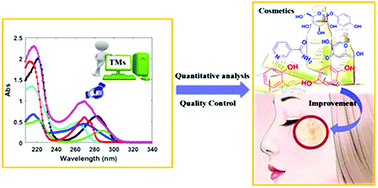An effective approach to the quantitative analysis of skin-whitening agents in cosmetics with different substrates based on conventional UV-Vis determination†
Abstract
Although UV-Vis spectroscopy has been applied in many fields, it still encounters some challenges in multi-component mixture analysis due to severe spectral overlapping and different interferences. In this paper, a Tchebichef curve moment (TM) approach has been developed and proposed for the quantitative analysis of five skin-whitening agents in several cosmetic products with different substrates based on conventional UV-Vis determination for the first time. First, the TMs were calculated from the raw UV-Vis spectra of mixed standard samples, and employed to establish linear quantitative models by stepwise regression. Then, the obtained models were applied to the analysis of real samples. The leave-one-out correlation coefficients (Rloo-cv) of the established models were more than 0.9948 within the linear ranges. The proposed approach was evaluated using intra- and inter-day precision (less than 5.98%) and recovery (ranging from 88.3 ± 2.8% to 109.2 ± 2.3%). The LODs and LOQs were less than 0.13 mg L−1 and 0.45 mg L−1, respectively. Compared with the classical methods, the proposed approach is not only more accurate, reliable and robust in the quality control analysis of cosmetic products, but also can extend effectively the application of conventional UV-Vis determination.



 Please wait while we load your content...
Please wait while we load your content...